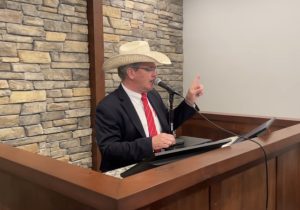R.F.D. News & Views
By Tim Alexander For Chronicle Media — July 7, 2025
One hundred and 20 acres of farmland sold for $19,000 per acre Wednesday in Sangamon County. The average value of farmland in Illinois per acre is $9,550, according to farmdocDAILY. (Sullivan Auctioneers photo)
With sincere apologies, this week’s column is heavy on the politics of agriculture. While we’d like to focus on crop progress and the weather — two of the farmer’s favorite topics this time of year — someone has to keep an eye on Washington. We did, so you didn’t have to. You’re welcome. Please read on …
‘Beautiful’ budget recon bill broken down
BLOOMINGTON — Illinois Corn has published an updated list of positives and drawbacks for farmers resulting from the passage of the “Big, Beautiful” Budget Reconciliation Bill (H.R.119) last week.
“Some provisions are good, some are less positive; IL Corn’s biggest concerns are around base acre updates, crop insurance changes, and viability of future Farm Bill,” Illinois Corn stated in an article published Thursday.
At or near the top of the list of positives, Estate Tax Relief will help farm families to pass their farm to the next generation. In addition, the Ensuring Permanency for 199A Qualified Business Income Deduction helps agricultural producers and farmers compete with larger corporations by allowing them to keep a portion of their income, according to Illinois Corn.
The organization further noted that making the lower individual tax rates and expanded tax brackets permanent in the Tax Cuts and Jobs Act was essential — allowing farmers to reinvest and manage increased production costs.
“Increasing Section 179 Expensing from $1 million to $2.5 million — important for substantial investments in equipment and technology: encouraging investment, productivity, and innovation,” Illinois Corn stated.
While the farm bill components of HR 119 are less favorable, Illinois Corn is appreciative of the doubling of Market Access Program and Foreign Market Development funds, which help to increase exports of corn and corn products like ethanol and meats. Illinois Corn is also pleased with the reconfigured Agricultural Risk Coverage program that better aligns corn payment rates.
CBO: Budget recon slashes farm bill, SNAP funding
URBANA — Breaking down the nuts and bolts of the funding behind the Budget Reconciliation Bill and its influence on the next farm bill’s crop insurance and nutrition programs was the University of Illinois farmdoc team. In an article published July 4 (“Farm Bill in Reconciliation: ARC/PLC Projections …”) the team reported the findings of the Congressional Budget Office, which projects that the Senate’s version of the reconciliation bill will add $3.3 trillion to the federal debt (not including interest costs on the debt). The bill is projected to reduce revenues (taxes) by $4.7 trillion, while reducing spending by $1.2 trillion over the next 10 fiscal years (FY2025-2034).
“Tucked into the budget reconciliation legislation is much of the Farm Bill, effectively reauthorizing it and making changes to policies under the protections of the special rules applicable to the reconciliation process. CBO projects the net reduction in Farm Bill spending by the reconciliation bill to be $120.25 billion (FY2025-2034),” the article stated, in part. “That reduction includes a total $185.9 billion cut for food assistance in the Supplemental Nutrition Assistance Program (SNAP) and about $73.5 billion (FY2025-2034) in additional spending. The additional spending is primarily the result of increasing payments and assistance to farmers ($66.4 billion, FY2025-2034). Most of the additional assistance to farmers is for Price Loss Coverage (PLC) payments ($50.5 billion, FY2025-2034), with a much smaller increase in Agriculture Risk Coverage (ARC) payments ($3.6 billion FY2025-2034).
“The bill also increases costs for crop insurance ($6.7 billion, FY2025-2034), trade promotion ($2.2 billion, FY2025-2034), and more. Finally, CBO scored a reduction in spending from conservation programs (-$1.8 billion, FY2025-2034), interaction effects (-$3.6 billion) and sequestration (-$2.2 billion).”
Stewardship Alliance: H.R. 119 ‘corrupt’
SPRINGFIELD — Prior to the House approving the Budget Reconciliation Bill, the Illinois Stewardship Alliance was rallying members to contact their Illinois representatives (a suggestion that Gov. J.B. Pritzker also took to heart) and urge them to vote no on H.R. 119, which was described as “rushed” and “corrupt.”
According to the ISA, the bill, which was signed into law by President Donald Trump on Independence Day,
- Makes deep cuts to food aid for families (SNAP),
- Fails to help farmers deal with increasingly unpredictable and disruptive weather events,
- Backtracks on climate action
- Increases funding for a handful of commodity crops that benefit only a fraction of farmers, while leaving behind smaller and more diverse farms.
“Families are already feeling overwhelmed and anxious about the rising cost of food and impending economic hardship — this bill would make it worse,” warned Liz Rupel, ISA’s deputy director, in an email to members on July 1.
Crop Protection Network provides new tool for farmers
URBANA — The University of Illinois is among the land grant universities to combine to offer a new online tool farmers and retailers may use to help track, manage, and treat insect pests and diseases of field crops. The Crop Protection Network is for farmers in the United States and Canada, according to Boris Camiletti, plant pathologist at the University of Illinois.
“Every extension plant pathologist in every state, we all met and created tools for farmers,” he said.
Using fungicide as an example, Camiletti explained that field trial data were gathered to create efficacy tables and ratings for foliar disease control, including “nearly every product available to the marketplace.” Ratings of the products are accessible on the website. A county-level database of insect pests and disease reports is also included.
Another feature of the Crop Protection Network, the Crop Disease Forecasting page, uses site-specific weather data to predict past and future foliar disease developments. Camiletti says it is designed to complement field scouting. However, “It’s still really important to scout the fields to see if you have the disease, and more importantly, to see if the disease is progressing over time,” he said.
Using a combination of the website’s tools, producers can see if a disease has been reported in their area, if conditions have or will be good for it to develop, in order to make field crop scouting treatment decisions using university recommendations. The interactive, map-based online tool will be updated throughout the growing season by university Extension specialists and research partners, including reports of diseases, pests, and other agronomic challenges as they develop.
Visit cropprotectionnetwork.org to access the new online tool for farmers. (University of Illinois/Todd Gleason)
Illinois Farm Fact:
120 acres of farmland sold on July 2 in Sangamon County, near Chatham, for $19,100 per acre, totaling $2.29 million. (Sullivan Auctioneers)







